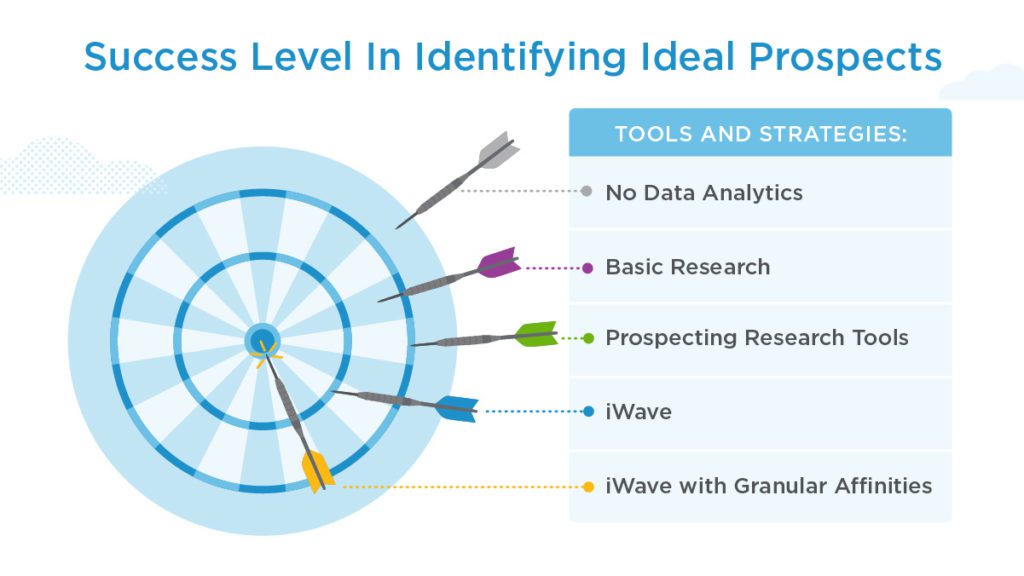Supercharge Your Prospect Research with More Granular Affinity Categories
Have you ever played a game of darts? This all-time favorite bar sport may seem a bit daunting for first-timers, but it’s actually easy to play. You start with a fixed number of points, typically 301 or 501, and the first player to get that score down to zero wins the game. Landing your dart in the smaller red or green ring on the outside of that section counts as double the number of points for that section, and landing your dart in the inner ring counts as triple the number of points. The Bull’s Eye will count 50 points.
Once you play a couple of games, you quickly learn that the fastest way to win is to aim for double and triple points. You don’t just throw the darts anywhere on the board, you aim for your best score. Donor prospecting works the same way. You can’t just expect anyone to turn into a major donor. The goal is to gear your efforts on individuals who will provide you the most value per opportunity.
Check out our ebook on Major Gifts from Major Donors here.
Now imagine that each dart you throw will cost you money, just like every outreach effort does. If you miss the board you won’t gain any new donations. Your goal needs to be to earn as many new donations as possible per outreach campaign. Success depends on how well you can land your darts on the areas that allow you to gain the most points.
Aiming at the optimal sections on the board will get you the most return for your fundraising efforts. These sections represent your ideal prospects. Those who have a long giving history, millions of dollars available to contribute another gift, and a strong affinity to your cause. How can you build up your ability to consistently identify ideal prospects?
Your prospecting productivity depends on the strategy and the tools that you use to identify ideal prospects:
- No data analytics: Fundraising without the use of data is like throwing darts with your bad hand. Chances are that you’ll miss the board and waste your efforts.
- Basic research: If you know your prospect’s street address, you can use a real estate site like Zillow to discover details on their properties and better understand their capacity to give. You’ll improve your accuracy and hit the board more consistently.
- Prospecting research tools: Using a screening tool will give you a better shot because you’ll tap into capacity and philanthropic data on your constituents. Now, you can hit the largest sections of the board more consistently, but you’ll be lucky if you hit the smaller areas that give you doubles or triples. Just because someone is rich and philanthropic, it doesn’t mean that they will support your cause.
- iWave: The most effective way to find ideal prospects is to use iWave. It’s no secret that affinity is the most important factor that determines how likely someone is to make a donation to your organization. iWave is built differently—it’s the only tool that is capable of assessing a prospect’s affinity to your cause by tapping into billions of external data points. Now you can hit doubles and triples like a pro. But there is a way to build more precision into your shot.
- iWave with granular affinity categories: Originally, iWave users were able to search across nine affinity categories, such as Education, Health, and Arts and Culture, to identify prospects who have a strong connection to a cause. But what if you want to dive deeper into a particular affinity group? Now you can with iWave’s new granular affinity categories, so you can hit those triples and a Bull’s Eye more consistently.
Individuals who aren’t ideal prospects are unlikely to support your cause, so engaging them repeatedly is throwing away money that would be better spent on prospects who are the most likely to give or increase their current giving. This is why affinity, how passionate a donor is about a cause or nonprofit organization, has long been a focus for iWave.
iWave users have already been able to use a powerful data-driven model to identify ideal prospects who have a strong connection to a cause by searching each across nine affinity categories. But some users indicated that they would like to dive deeper and build segmentation that is more granular because some individuals may only have an affinity for a more specific cause. This is why iWave launched granular affinity categories—the ability to evaluate a donor’s affinity across thirty categories, including museums, higher education, and youth development.
Now, iWave users can create ultra-targeted segmentation and cultivate messaging that is relevant to more specific interests. Plus, with the help of the recently released Multi-Lens Scoring feature, researchers can view wealth screening results and donor profiles under different affinity settings, and easily adapt segmentation to campaign changes.
With granular affinity categories and the right strategy, targeting the right donors and becoming a “sharpshooter” has never been easier.
To get started, a subscription to iWave is required. You can sign up for a free customized demo here.
Stay Up-to-date on Fundraising News and Resources
